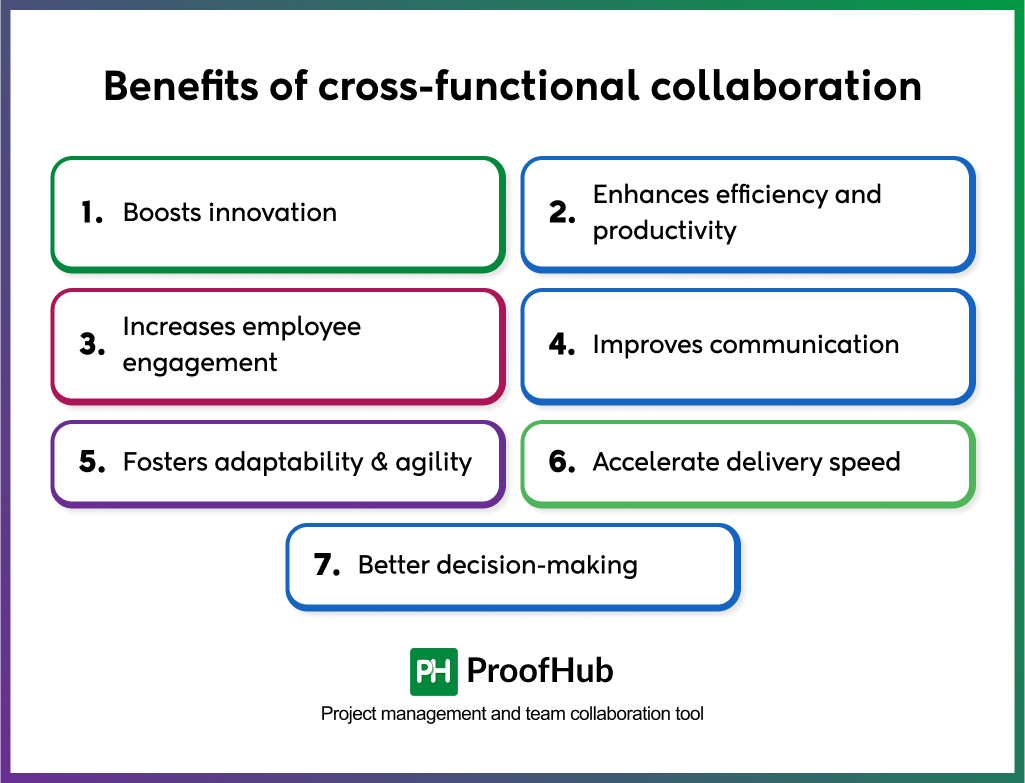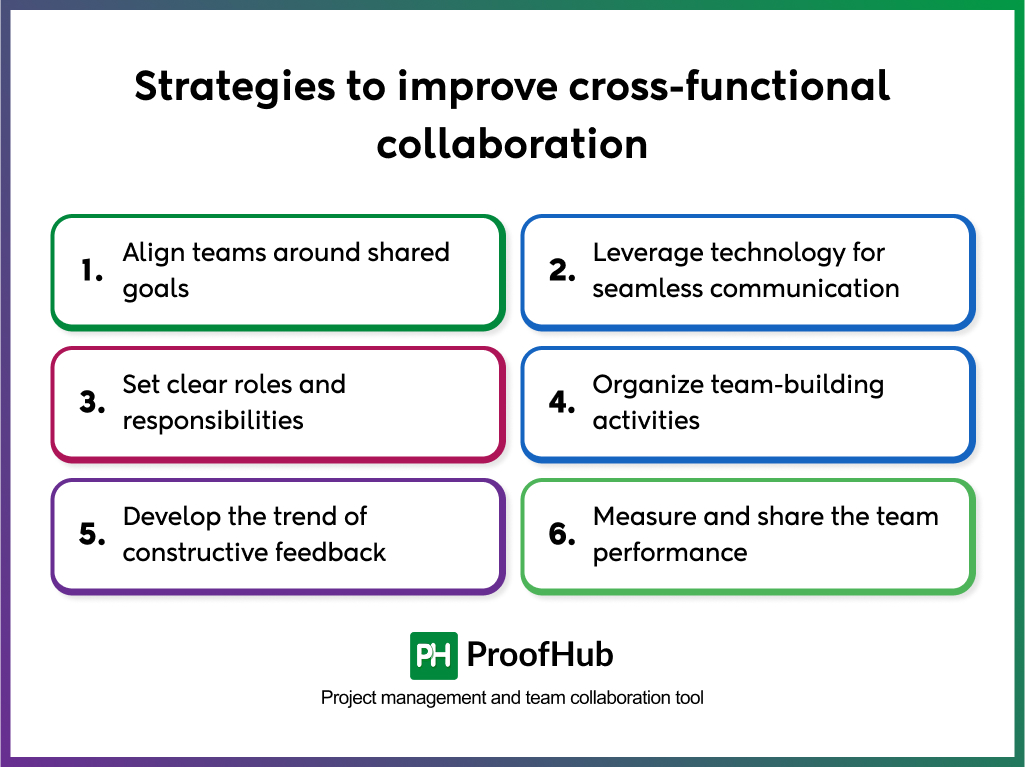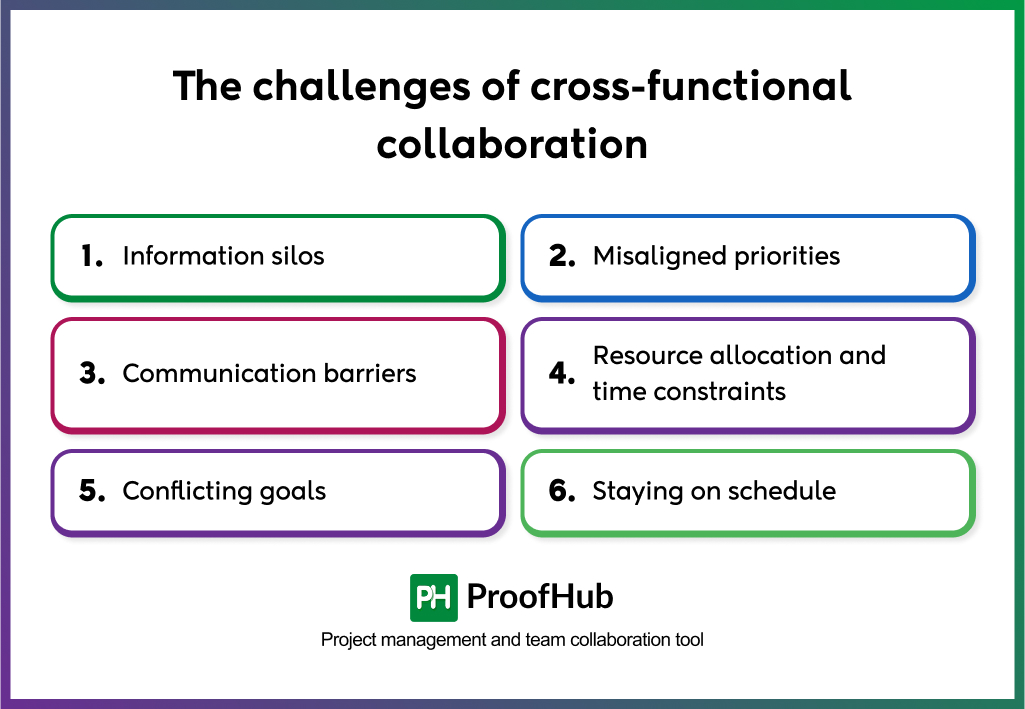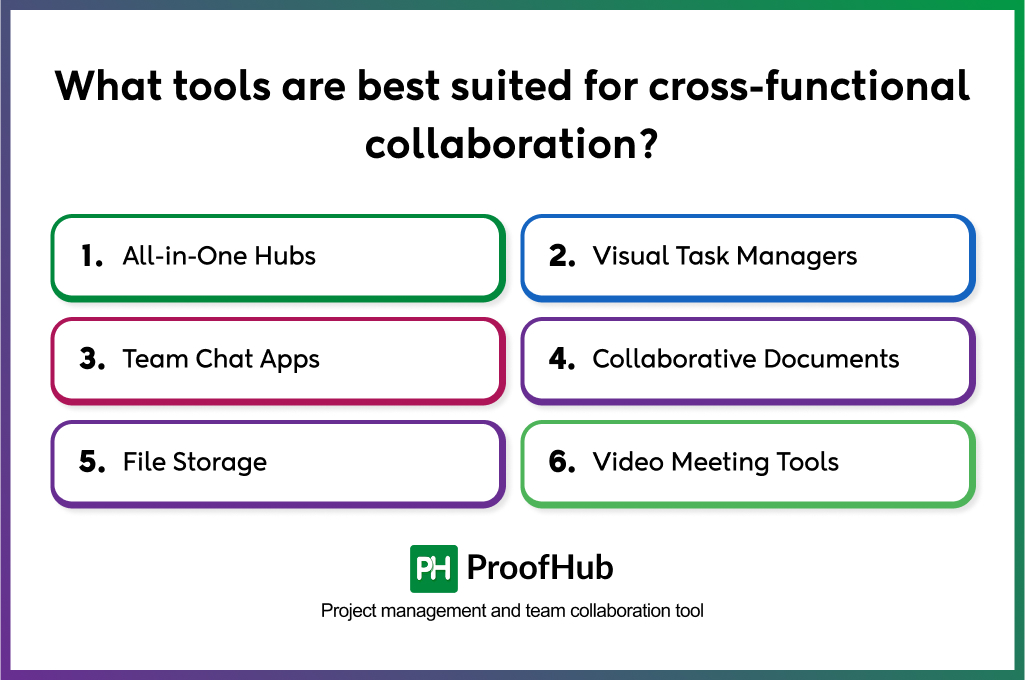
Cross-functional collaboration brings together professionals from different departments to leverage diverse expertise, perspectives, and skills towards shared goals. It transforms how organizations achieve common objectives by breaking down traditional silos, improving communication, accelerating decision-making, and strengthening problem-solving capabilities.
It stimulates innovation through knowledge sharing, improved efficiency by reducing duplicated efforts, higher employee engagement, and faster project delivery. The successful implementation of this requires precise goal alignment, strong leadership, effective communication tools, and a culture of constructive feedback.
Practical strategies involve defining shared objectives, leveraging collaboration technology, and establishing transparent performance metrics. This article covers actionable insights to help organizations make the best of cross-functional collaboration for better business outcomes.
What is Cross-functional Collaboration?
Cross-functional collaboration is a process in which professionals from different teams, departments, and educational backgrounds work together toward a common goal. Each contributor brings their own functional expertise and specialization that is necessary for the project to be successful.
This collaboration leads to better communication and understanding between departments, thereby enhancing decision-making and empowering teams to work together.
Why is cross-functional collaboration important for organizations?
Cross-functional collaboration enhances efficiency, strengthens communication, and drives innovation by uniting diverse teams around a shared goal. When individuals from different departments bring their unique expertise and perspectives together, it leads to more creative problem-solving and well-rounded decision-making.
This collaborative approach helps organizations adapt to the latest market changes, respond to customer needs, and have an advantage in today’s complex business environment. In addition, it can drive organization’s effectiveness while ensuring that team members are all working together.
What are the benefits of cross-functional collaboration?

Cross-functional collaboration offers several benefits for organizations. It enhances efficiency, boosts innovation, improves communication, and increases overall productivity by bringing together diverse skills and perspectives. This approach helps teams develop solutions that are technically strong, user-focused, and practical to implement. It also promotes employee engagement and stronger alignment across departments, ensuring that everyone works toward shared business goals.
Let’s look at the benefits of cross-functional collaboration.
1. Boosts innovation
Cross-functional collaboration allows individuals from diverse perspectives to exchange knowledge across different areas, creates learning opportunities, and encourages individuals to think outside the box to generate fresh ideas that drive innovation.
2. Enhances efficiency and productivity
When people from different departments collaborate, they share expertise, combine resources, and redistribute workloads. It leads to quicker problem-solving and faster project completion, resulting in increased employee productivity and efficiency.
According to the study “Optimizing Cross-Functional Team Collaboration in IT Project Management”, conducted by Vanitha Sivasankaran and team in 2024, found that cross-functional collaboration enhances efficiency and productivity by leveraging the diverse strengths of team members from different functional areas, which leads to improved problem-solving capabilities and more efficient resource utilization.
3. Increases employee engagement
When employees know how their work contributes, they feel valued. It builds strong professional relationships, which lead to better engagement and commitment.
4. Improves communication
Cross-functional collaboration helps break down departmental silos, foster better information flow, increase understanding between teams, and promote a more positive work environment.
5. Fosters adaptability & agility
Cross-functional teams are better equipped to handle complex challenges and adapt to changing circumstances. By combining varied perspectives, organizations can respond to shifts more efficiently and cultivate a culture that embraces change, enabling teams to pivot quickly and seize new opportunities.
6. Accelerate delivery speed
Collaboration between different departments reduces conflicting priorities, eliminates duplicate efforts, and closes knowledge gaps. As a result, teams can streamline workflows, minimize wasted effort and deliver projects faster.
7. Better decision-making
Decision-making process becomes more informed, aligned, and effective when input comes from different individuals. This also reduces inconsistencies, ensures clarity across teams, and leads to stronger, more strategic decision-making.
Strategies to improve cross-functional collaboration

Improving cross-functional collaboration requires intentional strategies to strengthen communication, alignment, and trust among diverse teams. Here are key strategies organizations can adopt:
1. Align teams around shared goals
Ensure individual team members and cross-functional objectives are aligned with the organisation’s broader goals. When team members understand their roles and how their work supports overall business goals, they’re motivated to collaborate effectively and less likely to operate in silos.
2. Leverage technology for seamless communication
Effective communication tools prevent collaboration from becoming disorganised. By using shared platforms for updates, timelines, and progress tracking, organizations can ensure that all teams—whether design, marketing, development, or product stay connected and updated.
3. Set clear roles and responsibilities
Defining who is accountable for decisions, deliverables, and approvals from the start speeds up workflows and empowers team members to take ownership without unnecessary dependencies. Ambiguity over roles is the major reason for overlap and delays.
4. Organize team-building activities
Use team-building to strengthen genuine working relationships. Activities like cross-discipline workshops, design sprints, or hackathons foster empathy, shared understanding, and smoother collaboration.
5. Develop the culture of constructive feedback
Healthy collaboration depends on open dialogue. Encourage teams to share feedback early and respectfully, especially across departments where perspectives differ. When feedback is normalized and valued, issues are identified earlier, misunderstandings decrease, and mutual trust grows.
6. Measure and share the team’s performance
Track metrics that reflect the overall effectiveness of collaboration and the project’s success as a whole, not only siloed KPIs. Measure indicators such as productivity, employee engagement, innovation outcomes, and communication efficiency.
What are the challenges of cross-functional collaboration?

Cross-functional collaboration creates friction when teams operate with different priorities, languages, and working methods. Understanding these underlying challenges enables organizations to build strategies that maintain alignment, clarify authority, and sustain productive momentum.
1. Information silos
Information silos prevent data sharing, leading to duplicate efforts and poor decision-making. When there is no centralized system, essential information becomes inaccessible to team members, which eventually leads to misinformed decisions, missed opportunities, and reduced efficiency.
Establish a clear project lead and define decision-making rights using a framework like a RACI chart (Responsible, Accountable, Consulted, Informed) to clarify roles and streamline authority.
2. Misaligned priorities
Different departments have their own priorities, which leads to conflict between departments. When teams prioritize their departmental targets over shared organizational goals, collaboration suffers.
Setting clear priorities and regular alignment meetings can help bridge these differences.
3. Communication barriers
Different teams use distinct terminologies, tools, workflows and have their own communication styles. What is clear to a web designer can be confusing to someone in sales, which leads to misunderstandings and slows down coordination.
Establishing common communication platforms and encouraging clear, inclusive language to create a more unified and productive environment.
4. Resource allocation and time constraints
Limited resources and time create competition between teams. Without visibility into each team’s capacity, resources become over-allocated, creating bottlenecks, burnout, and conflicting demands for the same people or funding.
Utilizing a shared resource management tool that displays everyone’s capacity and commitments in real time enables preventing overallocation.
5. Conflicting goals
When individuals from different departments prioritize different goals, objectives are misaligned with the organizational priorities, leading to non-uniform efforts.
Create a shared understanding of the company’s vision, mission, and primary goals, and ensure that all departmental goals support them. Encourage open communication to diminish conflicting goals and ensure coordinated efforts towards common objectives.
6. Staying on schedule
Without a unified collaboration plan, departments may work at different speeds, causing dependencies to be missed and timelines to slip. A delay in one area (e.g., product development) directly impacts the schedule of another (e.g., marketing launch preparations), creating a cascading effect.
Implement a shared collaborative timeline with clear milestones and dependencies that are visible to all. Hold regular, brief check-ins where teams report progress and identify potential schedule risks early.
What are the examples of cross-functional collaboration?
Some examples of cross-functional collaboration include-
Example 1. New product development
When a new product is developed, different departments get involved. R&D designs the product, the marketing department conducts market research, the sales department provides customer insights, and finance assesses budget feasibility. When these departments collaborate, it ensures that the product is cost-effective, ready for market, and meets expectations.
For example, the engineering team might design a prototype while marketing tests customer reactions before full-scale production.
Example 2. Marketing campaigns
Cross-functional collaboration ensures that the marketing campaigns are effective. Designers create visuals, IT supports digital platforms, sales provide insights on customer preferences, and marketing lays down the strategy. This kind of collaboration ensures that the perspectives of everyone are included. For instance, a product launch email campaign requires marketing content, design graphics, and IT’s technical setup at the same time.
Example 3. Customer experience enhancement
Improving the customer journey is essential for businesses. It involves customer service reporting pain points, UX designers redesigning interfaces, product teams adjusting features, and marketing updating communications. It ensures a seamless experience across touchpoints. For example, feedback about a confusing app feature could trigger UX and product teams to redesign it, while marketing communicates the update to users.
What tools are best suited for cross-functional collaboration?

The best cross-functional collaboration tools include centralized all-in-one hubs, visual task management tools, team chat apps, collaborative documents, file management tools, and video meeting tools. They help teams communicate, manage tasks, and share information. These tools ensure that employees across various functions—such as marketing, operations, finance, and IT—can coordinate efforts, share updates in real time, and achieve common organizational objectives efficiently.
1. All-in-One Hubs: Tools like ProofHub, ClickUp, and Monday.com combine everything in one place—task lists, timelines, team chat, and progress reports. They are ideal for keeping the entire project organized and visible to all.
2. Visual Task Managers: For teams that prefer a visual layout, tools like Trello and Jira use boards, cards, and timelines to show who is doing what and what stage each task is in.
3. Team Chat Apps: Slack and Microsoft Teams are great for quick, everyday communication. They allow teams to create channels for different topics, share updates instantly, and reduce email clutter.
4. Collaborative Documents: Google Workspace, Notion, and Confluence let multiple people work on the same document, spreadsheet, or knowledge base at the same time. This ensures everyone has access to the latest information.
5. File Storage: Google Drive and Dropbox provide a secure and straightforward way to store and share project files, so no one has to search through old emails for the latest version.
6. Video Meeting Tools: Zoom and Google Meet enable face-to-face interaction for important discussions, decision-making, and building team connection, especially when people are working remotely.
What is the difference between cross-functional and cross-departmental collaboration?
Cross-functional collaboration involves team members from different functions, disciplines, and skills (such as design, marketing, development, and content) working together to achieve a shared goal. It focuses on leveraging diverse knowledge and capabilities to solve complex problems, innovate, and drive results.
Cross-departmental collaboration, on the other hand, refers to cooperation between departments within an organization (such as IT department, HR, and marketing) to improve processes, prioritize, and align organizational goals.
While cross-functional collaboration emphasizes skill diversity, cross-departmental collaboration emphasizes coordination and alignment between departments.
What skills support effective cross-functional teams?
Effective cross-functional teams rely on interpersonal, analytical, and organizational skills. Strong communication and active listening ensure that team members from different functions understand goals, tasks, and updates, while collaboration and teamwork foster respect for diverse perspectives.
Problem-solving and critical thinking help navigate complex challenges, and adaptability allows members to respond to changing priorities or unexpected obstacles.
What collaboration styles suit cross-functional teams best?
Facilitative collaboration is especially effective for cross-functional teams because it creates an environment where team members feel comfortable asking questions and challenging ideas without fear of judgment. This approach focuses on building consensus and aligning the team around a common goal, making it easier for teams to work together effectively and efficiently.
Encouraging open discussion and providing a structured framework for decision-making helps to overcome conflicts and build strong team bonds.
How does cross-functional collaboration relate to innovation?
Cross-functional collaboration drives innovation by bringing together people with diverse skills, experiences, and perspectives. When teams from different functions—such as marketing, engineering, design, and operations—work together, they share ideas, challenge assumptions, and approach problems from multiple angles.
This diversity of thought sparks creativity, uncovers new opportunities, and leads to innovative solutions that may not emerge within a single-function team. By encouraging open dialogue and combining expertise, organizations can accelerate idea generation and turn creative concepts into practical, market-ready innovations.
What role does organizational culture play in cross-functional success?
A culture that values trust, openness, and shared accountability encourages teams to communicate freely, share knowledge, and work together toward common goals. When employees feel safe to voice ideas, provide feedback, and challenge assumptions, collaboration becomes more effective, and innovative solutions emerge.
Conversely, a culture that fosters silos, competition, or rigid hierarchies can hinder cooperation, create misunderstandings, and reduce the impact of cross-functional initiatives. In short, a supportive and inclusive culture lays the foundation for collaboration, alignment, and long-term success across diverse teams.
What are the common communication barriers in cross-functional teams?
Cross-functional teams often face communication barriers due to differences in departmental jargon, priorities, and working styles. Teams may use specialized language that others don’t understand, leading to confusion or misinterpretation.
Misaligned goals or unclear roles can also create misunderstandings, while information silos prevent critical updates from reaching all team members. Additionally, differences in communication preferences—such as email versus instant messaging—or geographical and time-zone gaps in distributed teams can slow decision-making and collaboration.
Recognizing and addressing these barriers is key to ensuring smooth, effective teamwork across functions.
How does remote work affect cross-functional collaboration?
Remote work affects cross-functional collaboration by reducing casual interactions, which diminishes the spontaneous exchange of new ideas and information between departments. While it requires reliance on digital tools, it can also provide opportunities for greater inclusivity by leveraging diverse, geographically dispersed talent and fostering a more comprehensive understanding of various perspectives.







